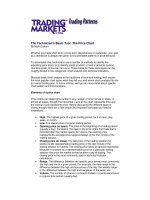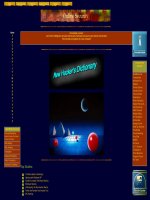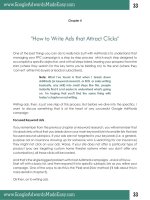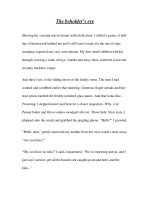Tài liệu The Hacker’s Diet How to lose weight and hair through stress and poor nutrition ppt
Bạn đang xem bản rút gọn của tài liệu. Xem và tải ngay bản đầy đủ của tài liệu tại đây (1.91 MB, 338 trang )
by John Walker
The Hacker’s Diet
How to lose weight and hair
through stress and poor nutrition
JOHN WALKER
Also by John Walker
THE AUTODESK FILE
c
Copyright 1991–1993, John Walker
All Rights Reserved
No part of this book may be used or reproduced in
any manner whatsoever without written permission
except in the case of brief quotations embodied in
critical articles and reviews.
S
ECOND (ELECTRONIC) EDITION
This book was published in December of 1993.
Typeset with L
A
T
E
X.
Trademarks
The following trademarks are registered in the U.S.
Patent and Trademark Office by Autodesk, Inc.: Au-
toCAD, Autodesk, AutoSketch, and AutoShade. The
following are trademarks of Autodesk, Inc.: Autodesk
Cyberspace and Cellular Automata Lab. The follow-
ing are trademarks of John Walker: The Hacker’s
Diet and Eat Watch.
Third-Party Trademarks
All brand and product names are trademarks or
registered trademarks of their respective compa-
nies.
CONTENTS
PREFACE 9
1 INTRODUCTION 11
About losing weight
11
About this book
12
About you
13
About me
14
About the computer tools
16
About pounds and inches
17
About time!
18
I Engineering 19
2 THE EAT WATCH 21
Food and feedback
23
Motivation and manipulation
24
Programmer, hack thyself
26
Problems: managing, fixing, and solving 28
What, me exercise?
32
2
CONTENTS
3
3 THE RUBBER BAG 34
What goes in
35
What you burn
36
What comes out
39
Inside the rubber bag
39
Seizing control
41
Input/Output
53
Food fads
56
Summary
60
4 FOOD AND FEEDBACK 62
Measure the quantity
62
Determine the goal
63
Apply negative feedback
65
Avoid positive feedback
69
Bang-bang vs. proportional control
73
Three possible outcomes
76
Three different people
76
Fun with feedback
87
5 SIGNAL AND NOISE 91
Wired science
92
Cause and effect
95
Dexter’s diet
96
Moving averages
103
The truth in the trend
114
Closing the circle
124
Exploring moving averages
126
6 WHAT, ME EXERCISE? 131
Living longer
132
Feeling better
134
The fitness ladder
135
Climbing the ladder
136
4
THE HACKER’S DIET
Introductory ladder 137
Lifetime ladder 140
How much is enough?
145
Progress and motivation 146
Details 151
II Management 156
7 WEIGHT MONITORING 158
Getting started
158
Every day 161
Every month 165
Every year
174
8 PLANNING MEALS 176
Why plan meals?
177
Calorie targets 178
How many meals, and when?
179
A regular schedule 181
Choose the chow
182
Eat watch in action 192
Summary 204
9 LOSING WEIGHT 206
Closing the loop
206
Getting ready 212
The initial plunge
219
The long haul 228
Late night, hungry, and alone 239
Success and stability
249
CONTENTS
5
10 PERFECT WEIGHT FOREVER 256
Regaining: the problem and the cause
257
Causes for confidence
258
Feedback forever 260
Proportional feedbag 275
Evading evangelism 277
The dream 278
III Details 280
11 PENCIL AND PAPER 282
Calculating daily trend 282
Calculating weight loss rate 284
Calculating calorie deficit 285
Making weight charts 285
Forecasting weight loss 286
Forecasting life extension
287
Calculating feedback models 289
Calculating moving averages 290
12 UNITS AND CONVERSION FACTORS 296
Units of Volume (Fluid Measure)
296
Units of Energy (Food value) 297
Units of Length 298
Units of Weight (Avoirdupois) 298
Units of Dry Volume 298
Abbreviations
299
The Weight of Water 300
13 CALORIES IN VARIOUS FOODS 301
ABOUT THE AUTHOR 332
6
THE HACKER’S DIET
INDEX 333
LIST OF TABLES
Daily calorie requirements, men 36
Daily calorie requirements, women
37
Calories consumed by exercise 131
Exercise ladder, introductory
138
Exercise ladder, lifetime
141
Weight log sheet, blank 162
Weight goals, typical men 254
Weight goals, typical women
255
Units of fluid volume
296
Units of energy
297
Units of length
298
Units of weight
298
Units of dry volume
298
Abbreviations
299
Weight of water
300
Calorie content of foods
301
7
8
THE HACKER’S DIET
PREFACE
This is not a normal diet book, and I am not a normal
diet book author.
I’m not a doctor. Nor am I a nutritionist, psychol-
ogist, sports hero, gourmet chef, or any of the other
vocations that seem to qualify people to tell you how to
lose weight.
I’m an engineer by training, a computer programmer
by avocation, and an businessman through lack of alter-
natives. From grade school in the 1950’s until 1988 I
was fat—anywhere from 30 to 80 pounds overweight.
This is a diet book by somebody who spent most of his
life fat.
The absurdity of my situation finally struck home in
1987. “Look,” I said to myself, “you founded one of
the five biggest software companies in the world, Au-
todesk. You wrote large pieces of AutoCAD, the world
standard for computer aided design. You’ve made in
excess of fifty million dollars without dropping dead,
going crazy, or winding up in jail. You’ve succeeded at
some pretty difficult things, and you can’t control your
flippin’ weight?”
Through all the years of struggling with my weight,
the fad diets, the tedious and depressing history most
9
10
THE HACKER’S DIET
fat people share, I had never, even once, approached
controlling my weight the way I’d work on any other
problem: a malfunctioning circuit, a buggy program, an
ineffective department in my company.
As an engineer, I was trained to solve problems. As a
software developer, I designed tools to help others solve
their problems. As a businessman I survived and suc-
ceeded by managing problems. And yet, all that time, I
hadn’t looked at my own health as something to be in-
vestigated, managed, and eventually solved in the same
way. I decided to do just that.
This book is a compilation of what I learned. Six
months after I decided being fat was a problem to be
solved, not a burden to be endured, I was no longer
overweight. Since then, my weight hasn’t varied by
more than a few pounds. I’m hungry less often at 145
pounds than I was at 215. I look better, feel great, and
have more energy for the things I enjoy. I spend only
a few minutes a day maintaining this happy situation.
And I know I’ll be able to control my weight from now
on, because I have the tools I need, the will to use them,
and the experience to know they work.
The tools are now in your hands.
Live long and prosper.
John Walker
Sausalito, California
January, 1991
1
INTRODUCTION
About losing weight
There’s an old Wall Street tale: a tyro asks an old-
timer, “How do you make money in the market.” The
wise man answers, “Nothing could be simpler: buy low,
sell high.” The beginner asks, “How can I learn to
do that?” The sage responds, “Ahhhh. that takes a
lifetime.” Simple doesn’t mean easy.
There is no magic secret to losing weight and keep-
ing it off, just as there is no hidden key to instant
wealth. Nonetheless, every year another crop of “magic
diet” and “secrets of investing” books appear on already-
creaking shelves. The human capacity to ignore incon-
venient facts and avoid unpleasantness is immense. Suc-
cess in any endeavour requires coming to terms with the
true nature of the task at hand and, if the goal is worth
the effort, getting on with it.
“How can I lose weight?” “Simple, eat less food than
your body burns.” “How can I learn to do that?” Read
this book.
11
12
THE HACKER’S DIET
About this book
This book is about.
How to. It’s a how-to book, but not a cookbook.
Everybody’s different, and no one diet is right for all.
This book will help you find a diet plan that works for
you.
. lose weight. Lose weight rapidly, and keep it off
permanently. Losing weight isn’t pleasant, and it’s far
better to get it over with quickly, and never have to do
it again.
. and hair . Just kidding. Actually, it seems to me
the life of a middle aged male is a race between hair
falling out of its own accord and getting ripped out over
stress and irritation. Women have it harder—they have
to rip it all out.
. through stress . Stress is an unavoidable conse-
quence of living in our fast-paced, high-tech culture,
yet few of us are willing to sacrifice its stimulation and
excitement to recapture the placid and serene life of sim-
pler times. Stress is a primary cause of overeating and
weight gain. You’ll learn how to break the cycle of
stress-induced eating and how to actually turn stress into
an ally in achieving your ideal weight.
. and poor nutrition. There is one, simple, unavoid-
able fact of dieting. To lose weight you have to eat less
food than your body needs. Only by doing so can you
cause your body to burn its reserves of fat and thereby
shed excess weight. If nutrition is about meeting your
body’s needs, losing weight involves deliberately short-
changing those needs—in a word, starving. This isn’t
a pleasant or inherently healthy process, but it’s bet-
ter than carrying around all that extra weight. You’ll
see how to reduce your food intake intelligently, so you
INTRODUCTION
13
don’t end up with scurvy or something else unpleasant
or embarrassing.
About you
This book is written for successful, intelligent, and mo-
tivated people who happen to be overweight. Whether
you’ve always been overweight, have been on a roller
coaster of dieting and regaining, or have just recently
added some excess poundage, the key resources you
need to achieve and maintain whatever weight and health
goals you set for yourself are the same as you need to
accomplish anything else worthwhile in life:
An eye firmly fixed on the goal.
Will power.
A high tolerance for pain.
I don’t mean this to be facetious; vaulting any of life’s
hurdles, whether success in school, business, sports, the
arts, or personal relationships requires the will and the
willingness to do what’s necessary, recognising that the
achievement will more than repay the investment of time
and energy you make.
This is the very key to success in anything—to be
able defer immediate gratification in pursuit of a more
permanent and worthwhile future goal.
This is precisely what losing weight involves. If you’re
successful in the things that matter to you but over-
weight, all you need to lose that weight is to make ac-
complishing your weight and health goals matter just as
much, then approach weight loss and control just like
any other important project: by developing and carrying
14
THE HACKER’S DIET
out a rational plan for success based on an understanding
of what’s involved in achieving it.
This book isn’t written for people who are or wish to
become obsessed with their health. I consider weight
control and fitness like any other aspect of life that’s
important enough to do, but hardly my reason for be-
ing. It’s like balancing the checkbook, going grocery
shopping, or getting the car tuned up. The goal is to get
the job done, and done right, as quickly as possible and
with the minimum effort.
About me
I’ve been overweight most of my life.
In 1987, not yet forty years old, I achieved the material
goals I’d been working for all my life. The company
I founded, Autodesk, Inc., had achieved a command-
ing position in its industry, enriching me beyond the
bounds of even my perfervid imagination. I’d handed
the management over to willing and capable people and
returned full-time to the work I love most, programming
and writing. I’d moved to a beautiful house on a cliff
overlooking the Pacific Ocean, shared with my intelli-
gent, resourceful, and attractive wife.
What’s wrong with this picture? Well, I was fat as a
hawg and in lousy shape. I hadn’t exercised since high
school. I’d lost some weight once in the mid 1970s, but
put it all back on in less than a year.
Life has a way of evening things out. And, I figured,
dropping dead before forty would balance out a great
deal of the success I’d clawed from the flinty soil of
life. What a drag.
So, there was nothing for it but to shed all those
INTRODUCTION
15
pounds I’d packed on through the stressful years of start-
ing, growing, and running a company. “If all you have
is a hammer, everything looks like a nail.” I’m an engi-
neer. I decided to approach weight loss as an engineer-
ing problem.
I studied the human body the way I’d tackle a misbe-
having electronic circuit or computer program: develop
a model of how it works, identify the controls that affect
it, and finally adjust those controls to set things aright.
It worked. In less than a year, totally under my own
direction and without any drugs or gimmicks, I went
from 215 pounds to 145 and achieved physical fitness.
Since then, I’ve kept my weight right where I want it
with none of the yoyo swings I’d suffered in the past.
All of this was accomplished in less than 15 minutes a
day, and without any significant changes in the way I
choose to live my life.
What’s more, I came to understand the game of weight
control. Confidence, founded in understanding and con-
firmed by success, makes maintaining an ideal weight
far more likely. What I discovered was so simple, so
obvious, yet so profound and useful I decided to make
the tools that worked for me available to everybody. So
I wrote this book.
I lost weight recently enough to remember clearly what
dieting involves but long enough ago to be confident I
have a way to avoid gaining it back. I understand what
you’ve gone through trying to lose weight previously. I
know what lies ahead. I’ve been there. It’s worth it.
16
THE HACKER’S DIET
About the computer tools
I’m a computer freak, so the first thing I did when
I started thinking about losing weight was develop a
bunch of computer-based tools to help me understand,
monitor, and control the process. Collecting the data,
analysing it with a computer, then applying the insights I
gained taught me more about losing and gaining weight,
and how the body works in general than a lifetime of
failed diets and a truckload of diet books. This book not
only explains what I’ve learned, it describes how to use
the tools to understand how your own body works.
The tools are all spreadsheets based on Microsoft Ex-
cel. Please refer to the README.DOC file which ac-
companies the tools for information about the hardware
and software they require. In addition to the spread-
sheets that let you plan, track, and chart your weight
loss, many of the tables in this book are also supplied as
Excel files so you can experiment with them and incor-
porate them into other health management tools. Each
table in the text supplied in Excel form specifies the file
name in computer type (for example, “WEIGHT.XLS”)
at the top of the table.
You don’t need a computer to lose weight. Every
technique in this book can be applied just as effectively
with pencil and paper, in little additional time. The com-
puter tools produce spiffier looking graphs, allow you to
play around with the data in amusing ways, and let you
experiment with “what-if” calculations without pencil
pushing. If you have a computer, you’ll appreciate the
convenience it affords, but it won’t determine whether
you succeed or fail in losing weight.
Chapter 11 provides “Pencil and paper” methods equiv-
alent to each computer-based calculation. In addition to
INTRODUCTION
17
making the techniques accessible to those without proper
computers, these sections also explain how the spread-
sheets work and are worth reading if you’re interested
in modifying them.
About pounds and inches
I usually use the metric system, but in this book I’ve
stuck to English units throughout. Even scientists who
work all day in metric units think of themselves as “five
eleven, one-sixty.” Metric units would only confuse
U.S. readers and make the essential techniques in the
book less accessible. I apologise to readers in more en-
lightened areas of the world. I’ve also conformed to the
somewhat sloppy practice in most nutrition books of us-
ing “calorie” to mean what is more precisely termed
“kilogram calorie” or “kcal”—the energy required to
raise the temperature of one kilogram of water one de-
gree Celsius. The “gram calorie,” 1000 times smaller,
is cumbersome when discussing the energy content of
food. In Europe, food energy value is frequently given
in kilojoules (kJ), the metric unit of energy. To convert
kilojoules to kilogram calories (“food calories”), divide
by 4.184.
The Excel spreadsheets allow you to specify whether
weight is measured in pounds, kilograms, or stones; each
spreadsheet which uses weight measurements contains a
cell near the top which specifies the unit of weight. If set
to 1 (as supplied), weights are in pounds. If you change
the cell to 0, weights are in kilograms. If you set it to
1, weights are measured in stones. Also included is
UNITS.XLS, an Excel worksheet providing conversion
factors among all the odd English units encountered in
18
THE HACKER’S DIET
connection with food (teaspoons per cup, for example),
plus their metric system equivalents.
About time!
Enough tedious preliminaries—let’s get on with it! The
sooner you start, the sooner you can put the overweight,
out of shape part of your life behind you.
You’ve probably already decided you don’t want to be
overweight. Otherwise, why read a diet book? You’re
about to learn what’s involved in achieving your goal.
Mastering and applying the tools for weight and health
management in this book will allow you to succeed,
probably within the next 12 months. By this time next
year, then, having reduced a nagging lifelong problem to
a few minutes a day of minor effort, you’ll look forward
to many additional healthy years replete with all the joys
life has to offer.
Part I
Engineering
19
2
THE EAT WATCH
My hunger serves me instead of a clock.
—Jonathan Swift, Polite Conversation,
1738
Wouldn’t it be great if you could visit your local pur-
veyor of electronic marvels and purchase one of these?
Weight
EAT
150
Marinchip Eat Watch
Turbo Digital
21
22
THE HACKER’S DIET
You strap it on your wrist, set it for the weight you
want to be, then rely on it to tell you when to eat and
when to stop. Whenever it says EAT, just chow down
on anything you like until EAT goes out. Obviously the
EAT indicator will stay on longer if you’re munchin’
cabbage instead of chugging M
¨
unchen’s finest beer.
As long as you heeded the Eat Watch, you’d attain
and maintain whatever weight you set it to. If you ate
the wrong foods or had your meals on an odd schedule
you might be hungry, but you’d never be fat. And, with
the eat watch guiding you, you’d rapidly find a meal
schedule and makeup that banished hunger forever.
The eat watch wouldn’t control you any more than a
regular watch makes you get to work on time. You can
ignore either, if you wish. You decide, based on the
information from the watch, what to do.
Some people are born with a natural, built-in eat watch.
You and I either don’t have one, or else it’s busted. But
instead of moping about bemoaning our limitations, why
not get an eat watch and be done with it?
You can’t buy an eat watch in the store, at least not
yet. But you can make one that works every bit as well.
It isn’t a gadget you wear on your wrist; it’s a simple
technique you can work with pencil and paper or with a
personal computer. It tells you same thing: when to eat
and when to stop eating. The eat watch you’ll discover
in this book is simple to work, easy to use, and highly
effective in permanently controlling your weight.
The next few chapters lay the background for build-
ing an eat watch. The principles on which the eat watch
is based are subtle and, although they’ve been used in
engineering for decades, seldom are mentioned in con-
junction with weight control. I’ll explain them in detail.
THE EAT WATCH
23
The road to understanding the eat watch is a long but
interesting one. When we reach its end, you’ll not only
know how to use an eat watch, but how and why it
works. Then you’ll have the confidence, founded on
knowledge, that your weight is totally and permanently
under your control.
Food and feedback
If people didn’t eat except when their bodies needed
food, nobody would be overweight. What a wonderful
world it would be! (Of course, there wouldn’t be a
market for diet books. .)
Hunger is supposed to tell us when it’s time to eat, but
in the modern world, we rarely rely on this message from
our bodies. We eat certain meals on a given schedule,
with family and friends. And, while hunger tells us
when to eat, there isn’t a corresponding signal that says
we’ve had enough. Only when the scale begins to rack
up extra pounds and the belt seems to need another notch
do we realise the cumulative effect of a little too much
food every day.
As long as you aren’t hungry, you’re probably get-
ting enough food, but how do you keep from eating too
much? What’s needed, along with food, is feedback—
information that tells how you’re doing—when to eat
and when to stop: the message of the eat watch.
I believe one of the main reasons some people have
trouble controlling their weight while others manage it
effortlessly is that there’s a broken feedback circuit in
those of us who tend to overweight. Our bodies don’t
tell us “enough already!”, while our slim and trim com-
rades, born with a built-in eat watch, always know when









